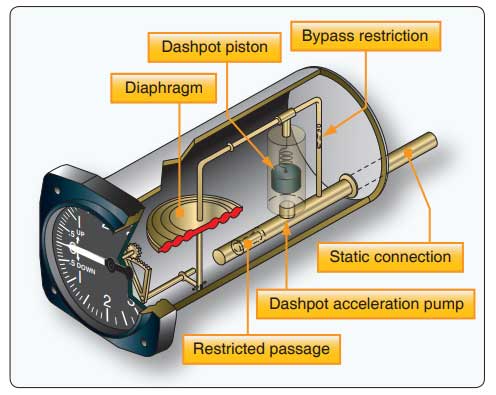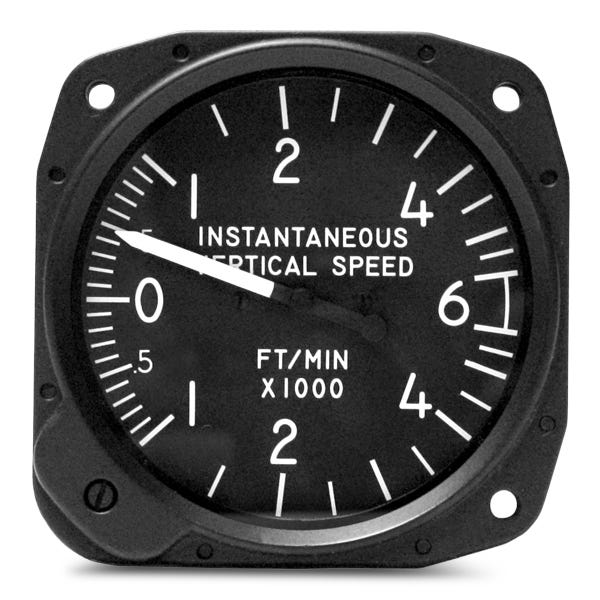
How Instantaneous Vertical Speed Indicators Combat Lag Time
September 3, 2019
Vertical speed indicators (VSI) measure the change in static pressure due to a change in altitude and present this information as the rate of climb or descent. Because the pointer on the VSI instrument face responds to the difference in pressure between two areas in the instrument, there is often a lag of six to nine seconds for the pressure differential to be established before the VSI can show the actual climb or descent rate, according to the Federal Aviation Administration. Instantaneous vertical speed indicators (IVSI) contain accelerometer-actuated air pumps to reduce the lag time inherent in simple VSIs.
Anatomy of an Instantaneous Vertical Speed Indicator

Source: Federal Aviation Administration
A VSI or IVSI displays vertical speed in feet per minute with the largest numbers representing thousands of feet per minute (fpm), and smaller increments as hundreds of feet per minute. When the aircraft is flying straight and level, the VSI needle rests at the “9 o’clock” position pointing to zero. As the aircraft climbs, the needle moves upward to show the direction and rate of climb; when the aircraft descends, the needle moves downward to show the direction and rate of descent.
The instrument case for both a VSI and IVSI contains an aeroid (or diaphragm) vented to the aircraft’s static system. A calibrated orifice in the sealed instrument case causes the pressure inside the case to change more slowly than the pressure inside the aneroid:
- When the aircraft climbs, the static pressure decreases, which allows the pressure inside the case to compress the aneroid and move the pointer upward to show a climb.
- Conversely, when the aircraft descends, the static pressure increases, allowing the aneroid to expand and move the needle downward to show a descent.
- When the aircraft levels off, the pressure inside the case equals the pressure inside the aneroid and the indicator points to zero.
An IVSI contains the same basic components as a VSI, but adds one or more accelerometer units mounted in the vertical axis to create a more rapid differential pressure at the initiation of a climb or descent. Pilots can tell an IVSI from a VSI by the words “Instantaneous Vertical Speed” or the letters “IVSI” on the indicator face.
How an IVSI Works
The accelerometer(s) in an IVSI consist of a weighted piston held in place by springs inside a cylinder (also known as a dashpot). The cylinder is connected on one end to the static pressure source and on the other end to the aneroid. The initiation of a climb or descent increases the g-force on the piston, causing it to move and instantaneously push air into the aneroid (in the case of a descent) or allow it to expand out of the aneroid (in the case of a climb). The instantaneous pressure differential caused by the moving piston provides a reading on the instrument case without any time lag.
After a few seconds of continuous climb or descent, the piston stops moving and the pressure differential between the static and case pressure takes over to provide the rate information as a normal VSI.
Benefits of Using an IVSI versus a VSI

Having an IVSI installed reduces the tendency to overcontrol the aircraft due to the indication lag time. According to the FAA’s Instrument Flying Handbook (page 6-6), the lag time is proportional to the speed and magnitude of the pitch change. Slow, small changes in aircraft pitch shorten the VSI indication lag time. But if the pilot quickly makes a large correction to the aircraft pitch to change altitude, the lag time increases, which may induce the pilot to overcorrect the aircraft.
Since an IVSI provides instantaneous indication of the climb or descent rate, the pilot is less likely to “chase the needle” and overcontrol the aircraft.
Learn More About Flight Instruments
Mid-Continent Instruments and Avionics is proud to serve as a resource for pilots, operators and aircraft enthusiasts. If you would like to learn more about other flights instruments in addition to IVSIs, visit our resource center. If you would like to speak to someone on our expert team, call 1-800-821-1212 or email mcia@mcico.com.
At Mid-Continent Instruments and Avionics we offer VSIs and IVSIs in new or overhauled condition from several manufacturers. Our knowledgeable staff will be happy to help find the right instrument for you.




